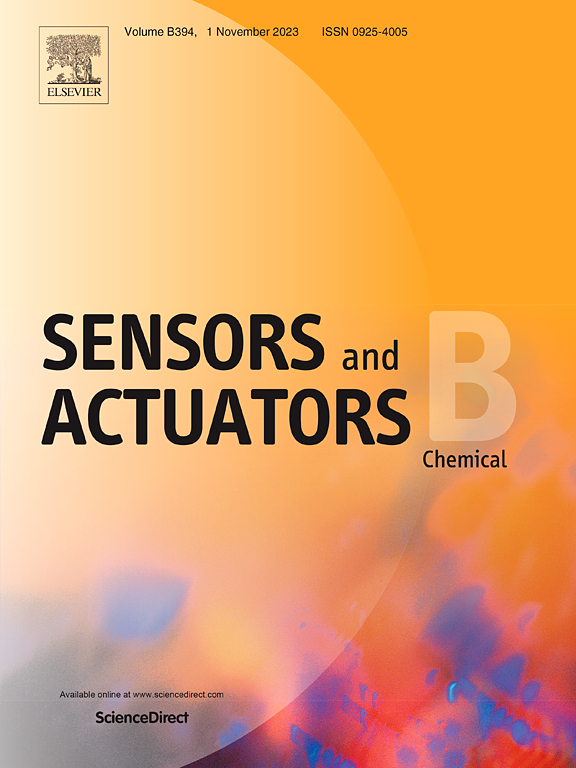一种GA-BP补偿PEDOT:PSS/MXene可穿戴式NH3检测装置,用于食品安全、环境监测和疾病诊断
IF 8
1区 化学
Q1 CHEMISTRY, ANALYTICAL
引用次数: 0
摘要
氨的实时准确检测对于食品新鲜度检测、农业监测和呼吸健康诊断至关重要。最近,柔性气体传感器因具有集成到智能可穿戴电子产品和显示设备中的潜力而备受关注。然而,开发高性能、低功耗和稳定的器件仍然具有挑战性。本研究设计了一种基于聚(3,4-乙烯二氧噻吩):聚(苯乙烯磺酸盐)(PEDOT:PSS)/MXene复合材料的化学电阻传感器,其中应用遗传算法优化的反向传播神经网络来补偿湿度,显著提高了检测精度。值得注意的是,在50 ppm NH3存在的情况下,使用遗传算法优化的反向传播神经网络将检测误差从8.06降低到1.3%。集成无线蓝牙监控系统,实现实时数据传输和远程监控。该传感器检测0.6 - 1000ppm范围内的氨,表现出优异的稳定性、选择性和灵活性,从而证实了PEDOT:PSS和MXene之间的协同效应。重要的是,在应用测试中,开发的系统可靠地评估了肉类腐败和农场通风水平,表明其高适用性和可靠性。成功的人体呼吸测试也为该传感器在呼吸健康监测中的应用开辟了新的可能性。本研究为食品质量保证、疾病诊断和环境监测提供了一种方便有效的方法。本文章由计算机程序翻译,如有差异,请以英文原文为准。
A GA-BP compensated PEDOT:PSS/MXene wearable NH3 detection device for food safety, environmental monitoring, and disease diagnosis
The real-time and accurate detection of ammonia is critical for food freshness testing, agricultural monitoring, and respiratory health diagnostics. Recently, flexible gas sensors have garnered attention owing to their potential for integration into smart wearable electronics and display devices. However, the development of high-performance, low-power, and stable devices remains challenging. In this study, a chemoresistive sensor based on poly(3,4-ethylenedioxythiophene):poly(styrenesulfonate) (PEDOT:PSS)/MXene composites is designed, wherein the application of a genetic algorithm-optimized back propagation neural network to compensate for humidity leads to a significantly enhanced detection accuracy. Notably, the use of a genetic algorithm-optimized back propagation neural network reduces the detection error from 8.06 % to 1.3 % in the presence of 50 ppm NH3. A wireless Bluetooth monitoring system is integrated to enable real-time data transmission and remote monitoring. This sensor detects ammonia within the range of 0.6–1000 ppm, demonstrating an excellent stability, selectivity, and flexibility, thereby confirming the synergistic effects between PEDOT:PSS and MXene. Importantly, in application tests, the developed system reliably assesses meat spoilage and farm ventilation levels, indicating its high applicability and reliability. Successful human breath tests also open new possibilities for the application of this sensor in respiratory health monitoring. Ultimately, this study offers a convenient and efficient approach for food quality assurance, disease diagnosis, and environmental monitoring.
求助全文
通过发布文献求助,成功后即可免费获取论文全文。
去求助
来源期刊

Sensors and Actuators B: Chemical
工程技术-电化学
CiteScore
14.60
自引率
11.90%
发文量
1776
审稿时长
3.2 months
期刊介绍:
Sensors & Actuators, B: Chemical is an international journal focused on the research and development of chemical transducers. It covers chemical sensors and biosensors, chemical actuators, and analytical microsystems. The journal is interdisciplinary, aiming to publish original works showcasing substantial advancements beyond the current state of the art in these fields, with practical applicability to solving meaningful analytical problems. Review articles are accepted by invitation from an Editor of the journal.
 求助内容:
求助内容: 应助结果提醒方式:
应助结果提醒方式:


